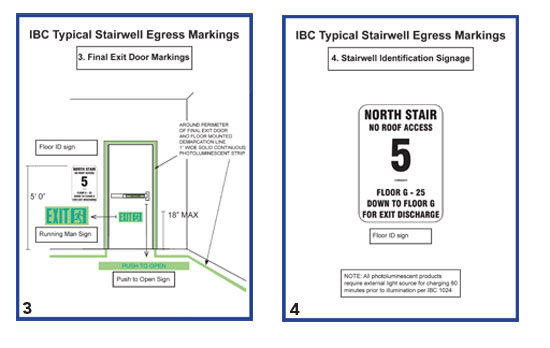Illuminated Stairway Identification
Glowing pathways aid building occupants and first responders
![]() Continuing Education
Continuing Education
Use the following learning objectives to focus your study while reading this month’s Continuing Education article.
Learning Objectives - After reading this article, you will be able to:
- Explain the concept of intuitive stairwell emergency egress using photoluminescent illuminated egress markings.
- Identify the six distinctive elements of multistory building stairwell photoluminescent egress markings.
- Determine the proper building codes to apply to the use and application of photoluminescent egress markings in egress stairways.
- Locate and identify the performance characteristics of building code-compliant photoluminescent egress markings based on standards established by UL, ASTM, and NFPA.
Photoluminescent (PL) technology saves lives by lighting a glowing path for a critical duration of time to evacuate occupants and navigate stairways during extreme circumstances like total darkness due to loss of power in a multistory building. PL glows through darkness and smoke-filled stairways, allowing first responders to get in and find their way to alleviate the threat and evacuate building occupants in a manner that is safer for everyone.
Introduction to Photoluminescent Egress Markings
PL egress markings are designed to create an intuitive path throughout the full height of an emergency stairwell or set of steps used for emergency egress in many types of buildings, such as high-rise office buildings, stadiums, arenas, hospitals, educational facilities, and many others.
The benefits of photoluminescent markings in these areas include:
- A luminous path that is intuitive to follow, guiding both occupants and first responders through an otherwise dark enclosure or series of steps to be navigated during an emergency evacuation.
- A fail-safe glow-in-the-dark source that is dependable even when backup generators or other electrical light sources are out of service.
- A strategically laid-out egress path that is intended to reduce or eliminate trips and falls on steps, collision with objects that protrude into stairwells, or potentially entering or exiting a doorway that is unsafe or heading in the wrong direction for emergency egress.
- An illuminated visual identifier that evacuees and first responders can use to quickly identify their current location and direction for egress, exit level location, and availability to roof access for rescue.
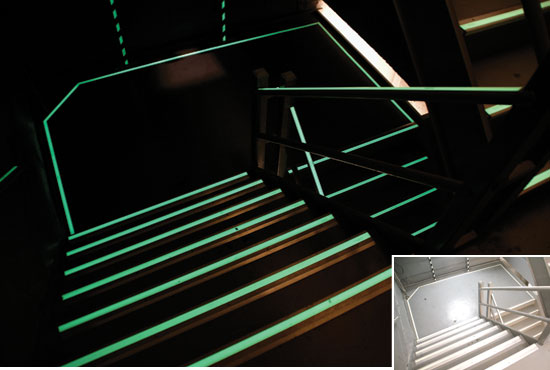 |
Time Warner's emergency stairwell exit uses handrails, stair treads, and demarcation products. Photos courtesy of Balco, Inc. |
Manufacturers and installers of egress components for multistory buildings developed the technologies and methods for applications that benefit a wide range of communities. Such benefits begin with the building occupants and first responders mentioned above and extend to the architectural and technical communities that now have enhanced life safety products to reduce life safety risks with choices that require very little energy and are primarily made of reusable resource materials.
Building codes refer to the photoluminescent markings in stairwells as “luminous” markings. You will see the terms “luminous,” “photoluminescent,” and “PL” throughout this article, all with the same meaning, which is a glow-in-the-dark marking that is charged by a light source and discharging a glow without the requirement of electricity.
History of Emergency Pathway Markings
Emergency pathway markers have been used in commercial applications in the U.S. and other countries for decades. Many pathway marking systems are charged electrically. Items such as exit signs above doorways and pathway lighting used in hallways of buildings as well as on transportation vehicles like ships, trains, and aircraft are now commonplace.
Photoluminescent pathway markings and signage are a tested and proven evolution from electrical technology to a chemically charged material applied to a solid surface. PL is a fast-reacting source of illumination and is reliable even when power failures occur coupled with failures of backup batteries and generators. Some slow-to-recover lighting sources like metal halide used in stadiums, arenas, and gymnasiums leave occupants in the dark for long periods of time that could be crucial to evacuation and first responder efficiency.
Photoluminescent illumination requires a minimal light source to charge the particles imbedded in the PL material. Discharging is constant and immediately apparent when the lights go out. Think of it like a cell phone connected to an electrical charger. The phone works while it is plugged in and it also works when it is unplugged but only for a particular duration. Then the phone slowly loses its charge over time. PL works in a similar fashion. It charges when lights are on and it glows all of the time. You only notice the glow when the lights are dimmed or completely out. The photoluminescent material glows bright enough to allow sufficient egress through the pathway for at least 90 minutes and then becomes less bright over time until the charge runs completely out or it is recharged by a light source.
The Science Behind PL
The most common materials used for commercial-grade luminous markings are referred to as either “self-luminous” or “photoluminescent.” Self-luminous materials are radioactive particles that do not require a light source for charging. This technology has been used in exit signs but not in emergency egress markings like the ones stated in this article. Self-luminous materials typically require regulation for tracking and disposal and are regulated by governmental agencies.
Photoluminescent materials are safe, non-toxic, and non-radioactive materials that require a light source for charging. The most common material used in commercial-grade photoluminescent products is strontium aluminate activated with a suitable dopant like europium.
Strontium aluminate is a solid, odorless, nonflammable, pale yellow powder, heavier than water. It is chemically and biologically inert. When activated with a suitable dopant (e.g. europium), it acts as a photoluminescent phosphor with long persistence of phosphorescence.1
 |
New York City's Barclays Center emergency stairwell exit door with markings Photo courtesy of SUMA Industries |
The required levels of phosphorescence are described in detail in the 2009 and 2012 version of the IBC/IFC 1024 building codes. They both reference UL1994 as the standard measure of acceptable glow requirements measured in terms of foot candles and Lux for charging and millicandelas for discharging of the glow materials. All measures are related to periods of time for charging and discharging.
The current UL 1994 standard states that the required charging source to illuminate and fully charge a photoluminescent path marking has a minimum of 1 foot candle (11 lux) capacity for a minimum of 60 minutes prior to terminating the light source in an egress stairwell. The required glow capacity for a photoluminescent material is a level of 30 millicandelas visible for at least 10 minutes and 5 millicandelas for a period of at least 90 minutes.
Minimal lighting is required at least 60 minutes prior to building occupancy, according to IBC/IFC 1024, to ensure that the PL materials are adequately charged and functional in the case of an emergency. The minimal source of lighting is less than the current requirement for lighting an existing egress stairwell in a high-rise building. Typical light sources include sunlight, fluorescent, incandescent, halogen, metal halide, and many others.
Building Types that Benefit from Luminous Markings
There are many building types that benefit from luminous markings for means of egress as well as practical function in an often darkened venue like a stadium or arena. There are other types of buildings that do not have adequate lighting to maintain the proper charge required for a commercial-grade PL material. Buildings such as high-rise structures, multistory office buildings, hospitals, K-12 schools, and universities are excellent examples of structures that have obvious benefits related to PL markings for means of egress. Stadiums and arenas are excellent examples of venues that benefit not only from emergency egress when lighting is lost unexpectedly but also when lights are dimmed for periods of time during performances. This is an example of the practical use of PL markings, allowing fans to make their way to concession stands and restrooms during darkened periods of the performance.
One great benefit of photoluminescent markings is that they are only visible when looked at from above. Performers on stage cannot see the glow from the stands on steps in an arena because they are not in the proper line of sight. This is not possible with electrical lighting. For this reason a vertical strip on the face of a stair nosing is not desirable.
Movie theaters and performing arts theaters are often dark for long periods of time. These venues are not usually good choices for photoluminescent markings unless proper light sources are pre-planned to create a suitable charging source.
The most common and practical building type that benefits from PL markings are high-rise buildings. The 2009 and 2012 International Building Code and International Fire Codes have specific and very detailed requirements for these types of structures.
High-Rise Building Egress
The dust has finally settled in the building code debates regarding high-rise building egress requirements. Now we can get on with the business of educating everyone who participates and benefits from the related code adoptions of 2009 and 2012 for the International Building Code (IBC) and International Fire Code (IFC). The list of beneficiaries begins with high-rise building occupants. The intended effect of the new codes was primarily to save lives of people escaping from any emergency that requires evacuation of a high-rise structure.
High-Rise Building Evacuation Philosophy
High-rise buildings are defined as any building with occupants at a level 75 feet or higher above fire department access, according to the NFPA 101 Life Safety Code. Manufacturers and installers have the responsibility to educate the public, first responders, code enforcement agencies, and architectural communities about high-rise building safety. Building occupant egress for high-rise buildings has changed strategy in recent years. The primary change is the philosophy of evacuation. The strategy used prior to the collapse of the World Trade Center towers on Sept. 11, 2001 was to evacuate occupants using a floor-by-floor method based on location of the danger. The current strategy is total building evacuation with measures taken as rapidly as possible.
Benefits Obvious to First Responders
The benefits quickly became obvious to first responders as well. First responders like firefighters, medical personnel, and law enforcement are now able to navigate a structure in the dark 30 percent more efficiently than before the codes were adopted.2 Both occupants and first responders gain a measure of safety due to the advances in product technology that lead to the adoption of new building codes in IBC and IFC for Chapter 10 Sections 1022 and 1024 “Means of egress.”
| Practical Use of Photoluminescent Egress Components | ||||
The 2012 versions of IBC and IFC Chapter 10 both have sections 1022 and 1024 that require six distinctive components of PL pathway markings for high-rise building egress. The six distinctive markings are: Per IBC/IFC Chapter 10 Section 1022 for version 2012 Stairway Identification Signage: 1. Stairway identification signage. A 12-inch-wide x 18-inch-tall sign is located 5 feet 0 inch above the floor in an egress stairway. The sign must be located in a place that is always visible, even when the door is open. (See figure 4.) The stairway identification sign must contain the following data:
Per IBC/IFC Chapter 10 Section 1024 for version 2012 Pathway Markings. 2. Stair nosings must be an integral part of the stair edge and have PL markings up to 1 inch wide within ½ inch of the leading edge of the step. The nosing must extend the full width of the steps. (See figure 1.) 3. Handrail markings must be placed on the top of the handrails for the continuous length of the handrails except for a 4-inch gap allowed at directional changes in the handrail. (See figure 1.) 4. Demarcation strips are required at stair landings to guide occupants in a path that is intuitive from one level to the next. Demarcation is also required to direct any pathway that leads to a final exit door. (See figure 1.) 5. Obstruction markings are alternately striped black and PL yellow to provide warnings of objects that protrude 4 inches or more into a defined egress path. Common obstructions inches from the landings or steps. (See figure 2.) 6. Final door markings are required only at the door leading directly to an approved building exit or for doors that must be passed through in order to reach a final exit door. (See figure 3.) Final exit door markings are:
|
| Excerpt from 2009 IFC 4064.23 Egress Path Markings |
“Historically, code requirements for high-rise buildings were written under the assumption that buildings would be evacuated floor-by-floor…Acts of terrorism and accidental incidents, such as power failures, have made it necessary to consider design for full building evacuation.” |
First responders are key to high-rise building safety because they bring order to very stressful and often chaotic emergencies. Their mission is to save lives. The advancements in PL technologies have increased the potential lives saved beyond building occupants and extended the life-saving benefits to first responders as well. They risk their lives as a routine part of their job. In Pennsylvania, three firefighters lost their lives because they were disoriented and did not know which level of the building they were on. This confusion is believed to have lead to them being trapped in a dangerous location with tragic results.3
IBC/IFC Chapter 10 Section 1022 was revised for the 2012 version of the code to require the addition of stairway identification signage with distinctive markings. These markings are intended to provide information for evacuees and first responders alike. Stairwell identification signage is required to be photoluminescent in high-rise buildings because PL is known to function for an extended period in complete darkness even when backup generators fail to operate.
After complete power is cut off or lost in a structure, PL egress markings light the way through darkness and smoke providing a 30 percent increase in rescue efficiency according to tests conducted at the firefighter training center in Anaheim, California, in 2011.4 PL egress markings were also proven to be as effective as standard lighting in a stairwell evacuation according to tests ran by a Canadian laboratory after the World Trade Center evacuations.5
Luminous stairway identification signage must be located in an area of the landing on the floor entrance level. The signs are not required at intermediate landing levels. The intent of stairway identification signs is multipurpose. Occupants in the process of evacuation can determine what level they are currently on and how many floors they must descend or ascend in order to reach an exit level. Persons who are visually impaired have two methods of determining the level they are currently on. The floor level can be written as numbers or letters and is affixed in a raised tactile character or characters in a 5-inch height. There is also a Braille insert just below the number notating the current floor level.
First responders and rescuers can also use the signage to determine the level they are on so they can identify how many floors must be ascended or descended in order to locate occupants, fellow rescuers, and the location level of a fire or emergency area. They can also determine if roof access is available when air rescue may be useful to evacuate occupants or rescuers needing medical attention.
The location of the sign is 5 feet above the floor and located in a place that is always visible, even when the door entering the stairway is opened.
Luminous stair nosings are intended to provide a stable, firm, slip-resistant component to the leading edge of egress stairs. This is according to the International Code Council (ICC) A117.1 Sections 504 and 302. Section 302 specifically addresses treads and risers, which are the horizontal and vertical components of steps respectively. Due to the absence of a specific requirement for slip resistance in the ICC, IBC, and IFC, the most commonly applied standard is the ADA recommendation of a Static Coefficient of Friction (SCOF) of 0.6 or higher for slip resistance. The standard test method outlined in ASTM C 1028-96 is commonly used to determine the SCOF for stair nosings. Most commercially available stair nosings exceed that standard and typically have a SCOF rating of 0.75 to greater than 1.0 when tested in either wet or dry applications.
The 2012 IBC/IFC sections 1009 identify the required tread and riser dimensions in order to create safe movement up and down steps. Treads must be a minimum of 11 inches deep and a maximum of 7 inches high when measured from the edge of one step to the edge of another above or below that step. It is important to note that the addition of stair nosings to existing stairs does not change the height from the edge of one step to the edge of another step. The measurement is taken from the top edge of one stair nosing to the top edge of the nosing of the next step.
2012 IBC/IFC section 1009.7.4 states, “Stair treads and risers shall be of uniform size and shape. The tolerance between the largest and smallest riser height or between the largest and smallest tread depth shall not exceed 3/8 inch in any flight of stairs.”
The luminous markings of a stair nosing are stated in the 2012 version of IBC/IFC 1024.2.1 “Steps.” The luminous marking is required to be placed within ½ inch of the leading edge of the step. It is restricted to a maximum of ½ inch wrapped around the vertical face of the step. The intent of this restriction is to reduce or preferably eliminate a vertical luminous marking on the face of a step. When ascending steps, the vertical face is more visible than when descending steps. Any luminous marking would reduce the delineation between the horizontal and vertical planes of a step. This could lead to trips and falls due to misplaced foot placement when ascending steps. A vertical luminous marking wider than ½ inch could result in a completely disoriented view of the steps causing them to look more like a ramp than a set of steps.
The depth of the luminous marking that is located at the leading edge of the stair nosing is stated to be a minimum 1 inch wide and maximum 2 inches, according to IBC/IFC 1024. There is an exception immediately noted that states the luminous stripe can be less than 1 inch if it meets UL1994 requirements, which were previously illustrated in the section “The Science Behind PL.”
Stair Nosing Types
Stair nosings can be made of many different components. The most common luminous stair nosings are made of extruded aluminum. They are typically filled with an abrasive filler to provide slip resistance. Stair nosings can be manufactured to be cast into concrete for new stairs or retrofitted on the surface of existing stairs. Extruded nosings can be made of single-component or two-component configurations.
For new stairs, a single- or two-component stair nosing is cast directly into the concrete step by attaching it to the formwork and then pouring the concrete around it. The result is a firmly placed stair nosing at the leading edge of the stairs. Two-component stair nosings are supplied for new construction by attaching a base extruded aluminum receiver directly into the concrete in the same fashion as the single-component application. The receiver extrusion includes a temporary wood filler that remains in place after the casting of the step until just prior to opening the stair for use. The wood filler is removed and replaced with an epoxy-filled aluminum extruded top section that snaps or screws in the base component creating a solid fixed-in-place nosing at the leading edge of the steps.
 |
Single component |
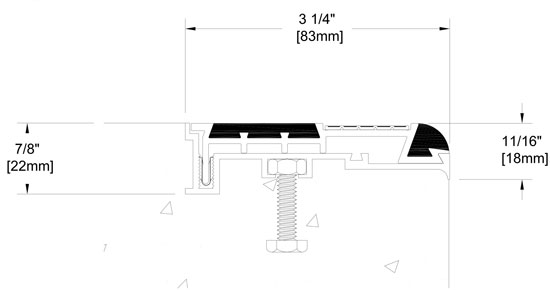 |
Two component |
 |
Retrofit |
Retrofit stair nosing applications require mounting an extruded stair nosing to the surface of an existing set of steps. Extruded stair nosings are less than 3/8 inch thick so they are within the building code and ADA requirements for riser height and tolerance for variation in steps within a single stairwell. Surface mounted stair nosings are generally glued and screwed to the surface of the stair tread to create a firm stable attachment. Retrofit applications are common when upgrading a building to current codes for increased safety of the occupants. They are also common for improving the condition of existing steps that have deteriorated over many years of use. It is common to supply the stair nosing the full width of a step. However, it is also common practice to leave a gap at the width edges of the stair nosing of 2 inches or less. There are several practical reasons for this common practice. First it allows for variations in the width of construction. There are sometimes irregularities in step widths in older stairs. Secondly, the gap at the edge allows for water to run down along the edges of steps when they are being pressure washed for cleaning. This avoids having water ponding behind the stair nosing with no place to go. It is a good practical solution for existing stairs and it meets the intent of supplying a nosing the full width of a step because the steps generally extend beyond the handrail so there is no foot traffic at that location.
Luminous Nosing Across the Step
Building codes are not universally accepted the same way or at the same time. States and municipalities have the authority to adopt variations of building codes to better meet the needs of their particular communities. The International Building Code and the International Fire Code adopted the method of requiring luminous marking the full width of the leading edge of steps with a stair nosing that is an integral part of the step. This requirement ensures that all steps are visible at all times to all occupants and first responders ascending or descending the steps.
This practice serves many purposes. The stair nosing must be an integral part of the step. The use of luminous film adhesive (tape) and paint do not adequately provide a stable attachment to the step. UL1994 stated in their IMZ1.Guideinfo that luminous paint applied directly to building surfaces do not meet the standards of UL1994 for “Luminous Egress Path-Marking Systems.” They stated, “Paint or pigment material must be pre-applied (at the manufacturing facility) to a substrate. Field application of photoluminescent pigment (by painting, spraying or similar method) directly to building materials or surfaces is not permitted due to uncontrolled application variables deemed significant for product performance.”
The application of “L” markings (see image) is not permitted by IBC/IFC because it does not clearly mark the full width of a step. Marking stairs with “L” markers at opposing sides of the steps leaves the majority of the traffic area of a step unmarked. This becomes significant during an evacuation where the stairwell and steps are crowded with people trying to navigate the steps at the same time. Occupants at the center of the steps could be limited in visibility of handrails and stair edges so the only visual luminous marking they can see would be the leading edge of the steps that are marked with an outlying luminous strip.
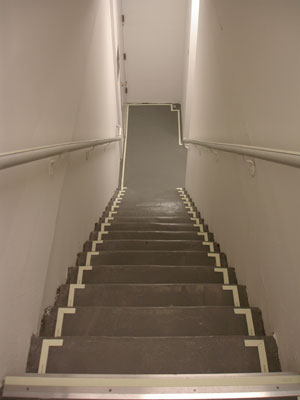 |
Luminous handrail markers. The primary purpose of a handrail along a set of stairs is for stability of a person navigating the stairs. Handrails are marked along their length with a continuous 1 inch wide stripe of photoluminescent material. A break of a maximum 4-inch gap is allowed at directional changes along the handrail in vertical and horizontal plains. Only the upper surface of a handrail is marked for visibility. The luminous marking is a visual indicator of the location of a handrail for use of occupants ascending or descending stairs. The marking also serves another very important purpose. The lineal stripe along the handrail becomes an intuitive path that is immediately noticed and followed from the top of a landing to the next level below.
The handrail marking flows seamlessly to the demarcation on the landings between stair levels and at the base level for a safe final exit from the structure. The seamless transition from steps to landings provides a secure and confident decision making environment in emergency conditions.
Handrails for emergency egress are often made of metal with a painted finish. PL markers are attached with either adhesive backing or applied with a liquid adhesive to ensure a solid and long lasting marking on the handrail. Handrail markers are generally made of film adhesive with a PL finish or made of metal with a durable factory applied paint finish. Film adhesives tend to be less expensive than metal markers but they require replacement periodically. This is especially true in stairwells that are frequently used by building occupants for exercise or a common alternate to taking an elevator up or down only a couple of floors at a time. Metal handrails tend to be more durable and tolerant in stairwells that are not temperature controlled as well as being resistant to uses other than the intended purpose of hands running along them as occupants travel up and down stairs. Handrails are commonly use as a slide for moving boxes and other objects down a set of steps. Durability and frequency of maintenance are items to consider when choosing a handrail marker based on the expected or potential use of the enclosure.
Luminous demarcation. Demarcation markings are required at landings between floor levels and at floor levels. The purpose of luminous demarcation is to create and continue the intuitive path from level to level in a stairwell. Demarcation markings create a well-marked path from the base of stairs, across the landing to the next set of steps. At the point of entry to the next set of steps are the markings on the handrails and the stair nosing strips. This flow has been described as looking “like a runway” by firefighters who have been through photoluminescent egress marked stairways.
The markings wrap completely around the landings and across the doorways that are not intended for exiting from the stairwell during an emergency. When the lights are out, occupants cannot even see these doors so they are not distracted by making a decision to enter the doorway or not. This is very important because a fire or other danger could be on the other side of that door. The markings continue from level to level until the final exit passage is reached.
Demarcation can be placed on the floor or on the wall at a landing area. Generally demarcation on floors must be metal and firmly fixed to the floors no more than 4 inches away from the perimeter of a landing. Demarcation can also be placed on the wall no more than 4 inches above the floor. In the wall placed application the demarcation strip must be turned downward to run along the floor in front of doorways that are not intended as exit passages. This condition is acceptable by code but it does create a slightly compromised flow of an otherwise intuitive and unbroken path across landing areas.
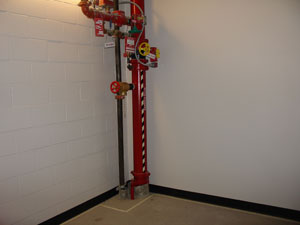 |
Barclays Center emergency stairwell exit obstruction markings Photo courtesy of SUMA Industries. |
Luminous obstruction markings. Obstructions are defined as any object protruding 4 inches or more into a defined egress pathway. The most common obstructions in egress stairwells are fire hose cabinets, standpipes with valve handles, fire extinguishers, sprinkler lines and header beams that extend below 6 feet 6 inches above the landings or steps. Luminous obstruction markings are labeled with distinctive alternating stripes that are 1 to 2 inches wide in black and PL Yellow coloring. The PL yellow coloring must meet the same glow standards as all other luminous markings in the stairwell. The alternating stripes are an immediately recognizable caution symbol and a distinctive departure from all of the other marking in a PL equipped stairwell.
Obstruction items often have irregular shapes like round surfaces or protrusions or awkward locations in a stairwell. PL film adhesives work well in these areas because they conform to shapes with relative ease compared to metal luminous markers. PL film adhesive is adequate for marking obstructions because they are not commonly used on a regular basis. Inspections and testing of equipment are the most common uses for items that are typically marked with PL film adhesive obstruction markers.
Luminous final exit door markings. Final exit doors and final exit pathways are critical components of an egress stairwell. The markings for these areas are distinctive and must be easily interpreted in an emergency evacuation. Demarcation strips for the floors stop at final exit doors and at doors that must be passed through to get to a final exit door. The floor demarcation strip stops at the doorframe and then runs vertically up the door frame (or beside the door frame on the wall), across the door head and then back down the opposite side of the door. This layout creates a quick and intuitive visual of a path that ends in an opening.
The door is marked with a directional exit sign with a minimum marking showing a 4-inch tall symbol of a running man according to IBC/IFC 1024 codes. NFPA is often used as criteria for signage. The word “Exit” in letters 4 inches tall are called for by NFPA life Safety section 101/170. So it is common to see final exit door markers with both the running man and the word “Exit” in a single sign.
It is also crucial to indicate the location of the door handle or push bar for a final exit door. These door handles must be marked with at least 16 square inches of luminous markings with no area less than 1 inch in width. Door handles and knobs are commonly marked with 4-inch by 4-inch plaques that are either blank PL markings or marked with curved arrow symbols indicating a turning knob.
Push bars and other long center mounted hardware are commonly marked with signage 2 inches wide by a minimum 8 inches long marking often marked with the words “Push to Open.”
Stairwell identification signs are placed 5 feet off the ground adjacent to the final exit door in a place that is visible with the door in an open or closed position. The stairwell identification sign is marked with the words “Exit This Level.”
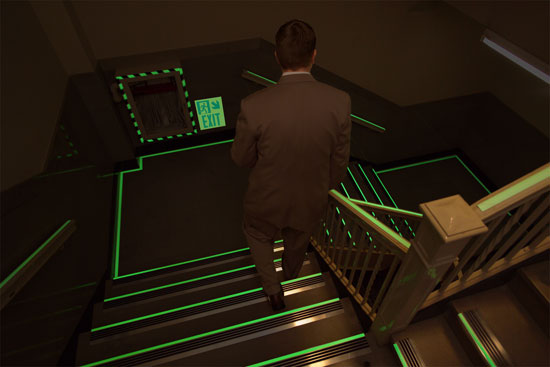 |
Conclusion
Photoluminescent egress path markings increase the efficiency related to evacuating a building in the dark. Occupants can see a clear path illuminated by the markings so they do not hesitate to proceed down steps from level to level until they reach safety. First responders improve rescue efforts and accountability for their team members because they can move 30 percent more rapidly throughout a darkened structure. They are able to rely on PL signage to indicate their location level as well as providing direction for roof access and direction of egress to better coordinate rescue efforts in multistory structures.
Benefits extend to any building that encounters a loss of lighting due to the loss of electrical power coupled with out-of-service or inoperable generators or battery backups. Building codes and test entities recognized the significant contribution that PL makes to life safety in buildings with stairs that must be navigated in the event of an emergency. PL markings for stair nosings and demarcation are low-level markings that make it possible to see them in a smoke-filled environment. It is clear to see that photoluminescent egress markings provide an immediate glowing pathway to safety.
| ENDNOTES | |
| 1 | Strontium Aluminate definition http://www.absoluteastronomy.com/topics/Strontium_aluminate#encyclopedia The source of the definition in this article is wikipedia, the free encyclopedia. The text of this article is licensed under the GFDL. |
| 2 | The Orange County Register website Nov 14, 2011, http://www.ocregister.com/news/firefighters-326592-photoluminescent-training.html. |
| 3 | FEMA Report USFA-TR-049 “Highrise Office Building Fire, One Meridian Plaza, Philadelphia, PA. February 1991. |
| 4 | The Orange County Register Website Nov. 14, 2011 http:/www.ocregister.com/news/firefighters-326592-photoluminescen-training.html. |
| 5 | Research Council of Canada – April 1999 and June 2007. Proulx, G., Benichou, N. Hum, J.K., Restivo K.N., 2007 Evaluation of the effectiveness of different photolouminescent stairwell installations for the evacuation of office building occupants, research report #232, Institute for Research in Construction, National Research Council Canada. |
 |
Balco, Inc. is a manufacturer of architectural products for the commercial construction industry. Balco's products include IllumiTread™ Photoluminescent Egress Systems, including stair nosings, signage, and markers. Other products include grates & frames, trench & access covers, stair nosings, architectural expansion joint cover systems, fire barriers and floor grids & mats. www.balcousa.com |


